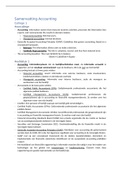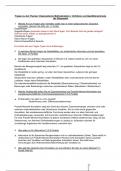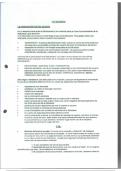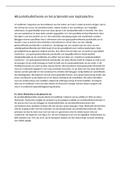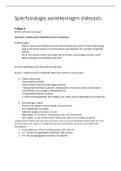Kostprijs berekenen
Zonder afval/uitval
Soorten variabele kosten:
Proportioneel
- Variabele kosten per product blijven gelijk
- Totale kosten stijgen
Degressief
- Variabele kosten per product dalen
- Totale kosten stijgen
Progressief
- Variabele kosten per product stijgen
- Totale kosten stijgen
Constante/vaste kosten zijn onafhankelijk van de productieomvang
Variabele kosten per stuk =
Verschil totale kosten / verschil productie
(Kosten p2 – kosten p1) / (productie p2 – productie p1)
Constante kosten per periode =
Totale kosten – (totale productie x variabele kosten per stuk)
Totale kosten bij een bepaalde productieomvang =
Vaste kosten per periode + (productie x variabele kosten per stuk)
Standaard kostprijs =
Constante kosten + Variabele kosten
Normale productie Werkelijke productie
C + V
N W
Integrale standaardkostprijs =
(Zelfde als standaard kostprijs)
Vaste kosten + Variabele kosten
Vaste kosten = totale vaste kosten / normale productie
Variabele kosten = totale variabele kosten / werkelijke productie
Totale kosten =
Totale vaste kosten + Totale variabele kosten
(Als de variabele kosten van bijvoorbeeld periode 2 nog niet bekend zijn doe je:
Vaste kosten + (verwachte productie x variabele kosten P1))
,Integrale commerciële standaardkostprijs =
Integrale standaardkostprijs + verkoopkosten
Capaciteit
Rationele capaciteit
1=N 2=S 3=R 4=O Aantal machines
Q1 … – +% capaciteit
Q2 – – +%
Q3 … – +%
Q4 … – +%
Totaal
Stap 1 = Normale productie
Stap 2 = Seizoensinvloed
Stap 3 = Reservecapaciteit
Stap 4 = Ondeelbaarheid machines
Overcapaciteit = O – N
(Naar oorzaken de rationele-overcapaciteit laten zien!)
Check = Overcapaciteit = (O – N)
1=S = (S – N)
2=R = (R – S)
3=O = (O – R) +
Check = overcapaciteit
Als er een vraag is met verschillende machines waarvan je er 1 moet uitrekenen, kan het zijn dat een
andere machine eigenlijk gunstiger is. Omschrijf dan bij de berekening van de rationele-capaciteit,
welke machine het beste is.
Stel je moet de rationele capaciteit berekenen van machine RW23 waar je 160.000 eenheden per
jaar mee kan produceren en je komt uit dat je maar 140.800 eenheden gaat maken en machine ODI
kan 150.000 eenheden per jaar produceren, valt je keuze toch op ODI.
, De rationele overcapaciteit bereken je dan ook met ODI.
Als je moet omschrijven, waarom er sprake is van een irrationele overcapaciteit en hoeveel het
verlies bedraagt als gevolg van deze overcapaciteit, omschrijf dan of het terecht of onterecht was om
RW23 aan te schaffen. In dit geval was het onterecht want ODI, had beter geweest, de rationele
beslissing was geweest om ODI aan te schaffen. Het verlies bedraagt dan €prijs van RW23 - €prijs van
ODI = €… aan constante kosten per jaar verlies.
Break-evenpunt
Break-evenafzet =
Q = C / (p – v) (Altijd naar boven afronden!)
Q = Afzet
C = Constante kosten
P = Verkoopprijs
V = Variabele kosten
Als je wilt uitrekenen hoeveel er verkocht moet worden om een winst na belasting te halen van een
bepaald bedrag, gebruik je de volgende formule;
Q = (C + Winst) / (p – v)
Aangezien het na belasting is, is het goed om de winst eerst een op een rijtje te zetten en te kijken
wat de winst voor belasting is. Dat doe je zo:
Winst voor belasting (100%) = €…,-
Vennootschapsbelasting (20%) = €…,-
Winst na belasting (80%) = €…,-
In de formule Q = (C + Winst) / (p – v), gebruik je dan de winst voor belasting (100%).
Break-evenomzet =
Q (break-evenafzet) x P (verkoopprijs)
Break-evenomzet (zonder de afzet te weten) =
Omzet
Totale variabele kosten –
Dekkingsbijdrage (= 25% van de omzet)
C/db
Constante kosten / 25% (0,25) dekkingsbijdrage = afzet
Veiligheidsmarge =
Hoeveel % de afzet of omzet kan dalen zonder dat de onderneming verlies maakt.
Werkelijke afzet – break-evenafzet x 100%
Werkelijke afzet
Zonder afval/uitval
Soorten variabele kosten:
Proportioneel
- Variabele kosten per product blijven gelijk
- Totale kosten stijgen
Degressief
- Variabele kosten per product dalen
- Totale kosten stijgen
Progressief
- Variabele kosten per product stijgen
- Totale kosten stijgen
Constante/vaste kosten zijn onafhankelijk van de productieomvang
Variabele kosten per stuk =
Verschil totale kosten / verschil productie
(Kosten p2 – kosten p1) / (productie p2 – productie p1)
Constante kosten per periode =
Totale kosten – (totale productie x variabele kosten per stuk)
Totale kosten bij een bepaalde productieomvang =
Vaste kosten per periode + (productie x variabele kosten per stuk)
Standaard kostprijs =
Constante kosten + Variabele kosten
Normale productie Werkelijke productie
C + V
N W
Integrale standaardkostprijs =
(Zelfde als standaard kostprijs)
Vaste kosten + Variabele kosten
Vaste kosten = totale vaste kosten / normale productie
Variabele kosten = totale variabele kosten / werkelijke productie
Totale kosten =
Totale vaste kosten + Totale variabele kosten
(Als de variabele kosten van bijvoorbeeld periode 2 nog niet bekend zijn doe je:
Vaste kosten + (verwachte productie x variabele kosten P1))
,Integrale commerciële standaardkostprijs =
Integrale standaardkostprijs + verkoopkosten
Capaciteit
Rationele capaciteit
1=N 2=S 3=R 4=O Aantal machines
Q1 … – +% capaciteit
Q2 – – +%
Q3 … – +%
Q4 … – +%
Totaal
Stap 1 = Normale productie
Stap 2 = Seizoensinvloed
Stap 3 = Reservecapaciteit
Stap 4 = Ondeelbaarheid machines
Overcapaciteit = O – N
(Naar oorzaken de rationele-overcapaciteit laten zien!)
Check = Overcapaciteit = (O – N)
1=S = (S – N)
2=R = (R – S)
3=O = (O – R) +
Check = overcapaciteit
Als er een vraag is met verschillende machines waarvan je er 1 moet uitrekenen, kan het zijn dat een
andere machine eigenlijk gunstiger is. Omschrijf dan bij de berekening van de rationele-capaciteit,
welke machine het beste is.
Stel je moet de rationele capaciteit berekenen van machine RW23 waar je 160.000 eenheden per
jaar mee kan produceren en je komt uit dat je maar 140.800 eenheden gaat maken en machine ODI
kan 150.000 eenheden per jaar produceren, valt je keuze toch op ODI.
, De rationele overcapaciteit bereken je dan ook met ODI.
Als je moet omschrijven, waarom er sprake is van een irrationele overcapaciteit en hoeveel het
verlies bedraagt als gevolg van deze overcapaciteit, omschrijf dan of het terecht of onterecht was om
RW23 aan te schaffen. In dit geval was het onterecht want ODI, had beter geweest, de rationele
beslissing was geweest om ODI aan te schaffen. Het verlies bedraagt dan €prijs van RW23 - €prijs van
ODI = €… aan constante kosten per jaar verlies.
Break-evenpunt
Break-evenafzet =
Q = C / (p – v) (Altijd naar boven afronden!)
Q = Afzet
C = Constante kosten
P = Verkoopprijs
V = Variabele kosten
Als je wilt uitrekenen hoeveel er verkocht moet worden om een winst na belasting te halen van een
bepaald bedrag, gebruik je de volgende formule;
Q = (C + Winst) / (p – v)
Aangezien het na belasting is, is het goed om de winst eerst een op een rijtje te zetten en te kijken
wat de winst voor belasting is. Dat doe je zo:
Winst voor belasting (100%) = €…,-
Vennootschapsbelasting (20%) = €…,-
Winst na belasting (80%) = €…,-
In de formule Q = (C + Winst) / (p – v), gebruik je dan de winst voor belasting (100%).
Break-evenomzet =
Q (break-evenafzet) x P (verkoopprijs)
Break-evenomzet (zonder de afzet te weten) =
Omzet
Totale variabele kosten –
Dekkingsbijdrage (= 25% van de omzet)
C/db
Constante kosten / 25% (0,25) dekkingsbijdrage = afzet
Veiligheidsmarge =
Hoeveel % de afzet of omzet kan dalen zonder dat de onderneming verlies maakt.
Werkelijke afzet – break-evenafzet x 100%
Werkelijke afzet



